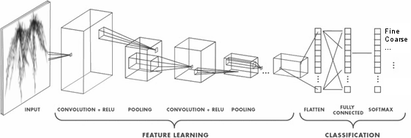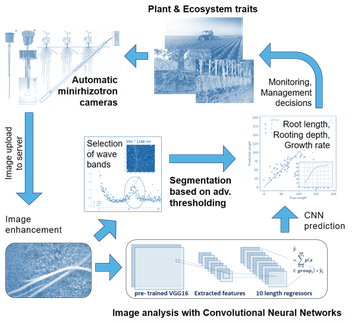Enabling next level research on roots - automatizing MR Image Acquisition and Analysis
NextMR-IAA [2019-2020] featured by ATTRACT

Minirhizotron (MR) imaging systems are key instruments to study the hidden half of plants and ecosystems, i.e. roots, mycorrhiza and their interactions with pathogens, fauna etc. in the rhizosphere. MR systems allow taking repeated images of roots etc. growing in soil (at specific depths) at the interface with transparent MR tubes; time between imaging must be shorter than the shortest turnover (expected).
In the last 20 years, MR imaging systems have received increasing interest in the fields of agronomy, forestry and ecology. However, despite scarce data on the “hidden half” of plants and ecosystems, e.g. needed for better understanding species’ ecophysiology, breeding resource efficient crops or determining soil C input via root litter, the technological advances remain yet limited. Potentially the high degree of instrument specialisation, and the subsequent lack of investment, led to only minor improvements of the available MR imaging technology (incl. minirhizotron camera automation) and image analysis software.
Currently, the state of the art in MR imaging instrumentation are either camera or scanner-based RGB system with limited resolution (300 dpi) — positioned and operated manually. Image analysis (e.g. for root tracking) is done, despite various efforts in the last decade to develop automated protocols, still largely based on manual overlays on images by human operators. Thus, the potential of MR imaging systems in plant and soil sciences but also in agriculture e.g. to support agricultural management decisions, such as fertiliser application and irrigation scheduling according to the phenological status of the (crop) root (especially rooting depth and density), is not realised yet.
The NextMR-IAA project (2019 - 2020) will
- combine state-of-the-art imaging sensors (UHD VIS and certain near infrared (NIR) wavebands) with imaging automation to allow for effective and precise imaging, and
- will develop machine learning-based approaches to automatically segmentate & classify roots.
NIR wavebands will e.g. allow for standardised root classification into dead and living and will thus significantly enhance the calculation of root turnover rates and subsequently information on ecosystems’ C budgets. Parallel soil moisture estimations will allow to continuously determine a key parameter influencing root growth.
The NextMR-IAA system will combine imaging technology, mechatronic automation and image analysing technology in a unique and highly innovative way to significantly advance the MR technology. The proposed technology has the potential to benefit society both indirectly via improving the capacity of researchers to study root and rhizosphere systems (e.g. in a C budgeting or plant breeding context), and directly via making root development information available to farmers in real time for precision farming (e.g. for early detection of (root) pests, or to optimise fertilisation and irrigation).
NextMR-IAA Project Report and Publications
Baykalov, P. et al. (2023). Semantic segmentation of plant roots from RGB (mini-) rhizotron images—generalisation potential and false positives of established methods and advanced deep-learning models. Plant Methods 19, 122. DOI:10.1186/s13007-023-01101-2
Further NextMR-IAA publications are in preparation. Follow the links for full texts.
NextMR-IAA Project Partners


Funding Source


